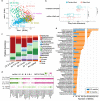A genome catalog of the early-life human skin microbiome
- PMID: 37946302
- PMCID: PMC10636849
- DOI: 10.1186/s13059-023-03090-w
A genome catalog of the early-life human skin microbiome
Abstract
Background: Metagenome-assembled genomes have greatly expanded the reference genomes for skin microbiome. However, the current reference genomes are largely based on samples from adults in North America and lack representation from infants and individuals from other continents.
Results: Here we use deep shotgun metagenomic sequencing to profile the skin microbiota of 215 infants at age 2-3 months and 12 months who are part of the VITALITY trial in Australia as well as 67 maternally matched samples. Based on the infant samples, we present the Early-Life Skin Genomes (ELSG) catalog, comprising 9483 prokaryotic genomes from 1056 species, 206 fungal genomes from 13 species, and 39 eukaryotic viral sequences. This genome catalog substantially expands the diversity of species previously known to comprise human skin microbiome and improves the classification rate of sequenced data by 21%. The protein catalog derived from these genomes provides insights into the functional elements such as defense mechanisms that distinguish early-life skin microbiome. We also find evidence for microbial sharing at the community, bacterial species, and strain levels between mothers and infants.
Conclusions: Overall, the ELSG catalog uncovers the skin microbiome of a previously underrepresented age group and population and provides a comprehensive view of human skin microbiome diversity, function, and development in early life.
Trial registration: ClinicalTrials.gov NCT02112734.
© 2023. This is a U.S. Government work and not under copyright protection in the US; foreign copyright protection may apply.
Conflict of interest statement
The authors declare that they have no competing interests.
Figures





Update of
-
A genome catalog of the early-life human skin microbiome.bioRxiv [Preprint]. 2023 May 24:2023.05.22.541509. doi: 10.1101/2023.05.22.541509. bioRxiv. 2023. Update in: Genome Biol. 2023 Nov 10;24(1):252. doi: 10.1186/s13059-023-03090-w. PMID: 37398010 Free PMC article. Updated. Preprint.
References
Publication types
MeSH terms
Associated data
Grants and funding
LinkOut - more resources
Full Text Sources
Medical

